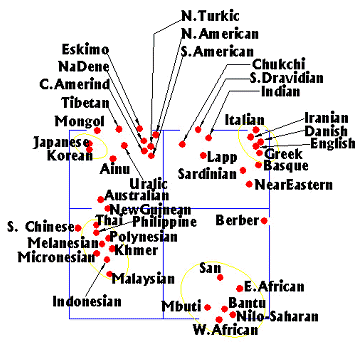GREEKS
It's been said that modern Greeks are racially different from their ancient predecessors, having over the centuries mixed with slaves and foreigners, including Negroids, and lost an allegedly Nordic character. The scientific data, however, shows tremendous continuity and near purity among Greeks, as well as a virtual absence of Nordic racial elements since the beginning of Greek history.
Anthropology
"It is inaccurate to say that the modern Greeks are different physically from the ancient Greeks; such a statement is based on an ignorance of the Greek ethnic character.... The Greeks, in short, are a blend of [sub]racial types, of which two are most important: the Atlanto-Mediterranean and the Alpine. Dinaricism here is present, but not all pervading; true Alpines are commoner than complete Dinarics. The Nordic element is weak, as it probably has been since the days of Homer. The racial type to which Socrates belonged [Alpine] is today the most important, while the Atlanto-Mediterranean, prominent in Greece since the Bronze Age, is still a major factor. It is my personal reaction to the living Greeks that their continuity with their ancestors of the ancient world is remarkable, rather than the opposite."
Genetics
In a sample of 125 Greeks from Thessaloniki and Sarakatsani, 2 Asian-specific mtDNA sequences (M and D) were detected (1.6%). No sub-Saharan African genes were observed in this population. Therefore, non-Caucasoid maternal ancestry in Greece is very low, as elsewhere in Europe.
* * *
In a sample of 366 Greeks from thirteen locations in continental Greece, Crete, Lesvos and Chios, a single African haplogroup A Y-chromosome was found (0.3%). This marks the only instance to date of sub-Saharan DNA being discovered in Greece. In another sample of 42 Greeks, one sequence of the Siberian Tat-C haplogroup turned up. Note that other studies with larger sample populations have failed to detect this paternal marker in the Greek gene pool (e.g. Malaspina et al. 2000; Weale et al. 2001), and that its frequencies are actually much higher in Scandinavian and Slavic populations.
(Di Giacomo et al. 2003;
Helgason et al. 2000)
* * *
In this autosomal DNA plot of genetic distances derived from 120 allele frequencies, Greeks fall entirely within the cluster containing Caucasoid populations (upper right corner), wedged between Basques and Northern Europeans, and far away from Africans and Asians:

(Cavalli-Sforza, Menozzi and Piazza, 1994)
* * *
A recent paper has detected clades of haplogroups J and E3b that were likely not part of pre-historic migrations into Europe, but rather spread by later historical movements. Greeks possess none of the lineages denoting North African ancestry within the last 5000 years, and have only 2% (3/148) of the marker J-M267, which may reflect more recent Middle Eastern admixture.
* * *An analysis of 10 autosomal allele frequencies in Southern Europeans (including Greeks, Cretans and other islanders) and various Middle Eastern and North African populations revealed a "line of sharp genetic change [that] runs from Gibraltar to Lebanon," which has divided the Mediterranean into distinct northern and southern clusters since at least the Neolithic period. The authors conclude that "gene flow was more the exception than the rule," attributing this result to "a joint product of initial geographic isolation and successive cultural divergence, leading to the origin of cultural barriers to population admixture."
Racial Types

Alpine (Sparta)

Dinaric (Epirus)

Mediterranean (Crete)
|
Related Topics
Racial Type of the Ancient Hellenes: Evidence that Greeks have always been Alpine-Dinaric-Mediterranean.
Arnaiz-Villena Study: Refutation of an often-cited paper that falsely claims Greek-Ethiopian affinities.
Sickle Cell: Not a tracer of African ancestry.
Tat-C: Frequencies of this marker in Northern and Eastern Europe.
Skin Color: Effects of sun-adaptation and tanning on Southern Europeans.
